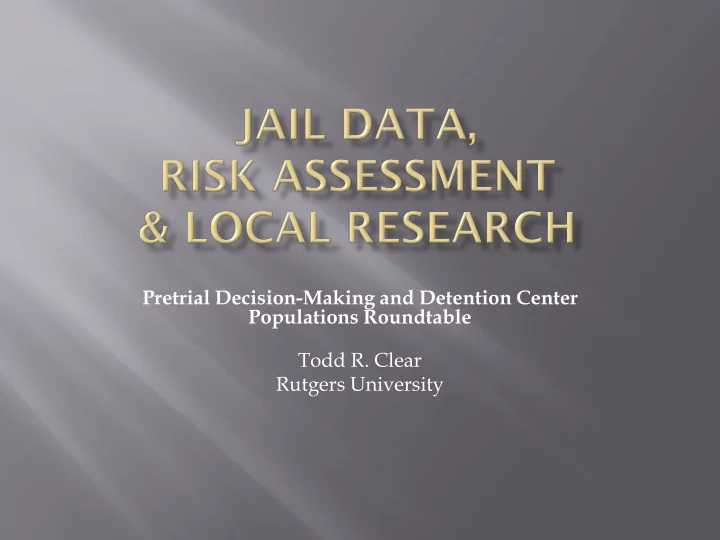

Pretrial Decision-Making and Detention Center Populations Roundtable Todd R. Clear Rutgers University
Local assessment Ability of a jurisdiction to use data to identify strategies that would reduce jail population Risk-based decision-making What ”risk” means, in practice, and how assessing it can help reduce jail populations Local research agenda What drives incarceration rates in Montana
The Population is created by (1) How many people go there and (2) How long they stay
Purpose 1: determine what is driving jail population ( Iron Law model of jail population) Purpose 2: give jurisdiction a chance to explore options for reducing jail population Purpose 3: provide data to inform strategies
Draw representative exit jail sample Slice of time Type of exit Estimate jail impact of different exit groups Select sample for detailed review Highest impact cases Complete process history Discuss cases, looking for ways to reduce jail population Divert from jail Reduce length of stay
Percent of Average Releases Release Category Number Length of Calculated ADP from Main Stay (days) Jail Total 7,865 40.1 - 863 CBCC/Work release 277 94.8 - 72 Electronic monitoring 176 151.8 - 73 Total Main Jail 7,412 35.4 100.0% 718 Bonded out 2,974 8.9 40.1% 72 Released on recognizance 1,439 6.1 19.4% 24 Transport to other agency 1,280 119.2 17.3% 418 Time or sentence served 1,127 50.9 15.2% 157 Court ordered 562 30.1 7.6% 46 Administrative release 14 11.2 0.2% 0 Charges dropped/dismissed 11 11.2 0.1% 0 Escaped/walk away 4 19.2 0.1% 0 Other 1 0.1 0.0% 0
Sample Average Length of Percent of Calculated Release Category Number Stay Releases ADP (days) Total 4,578 16.4 100.0% 206 Bond posted 1,414 3.5 30.9% 14 Own recognizance 774 4.3 16.9% 9 40 Released to requesting agency 671 45.1 14.7% 83 5 Sentence served 469 10.9 10.2% 14 10 Transport by other agency 318 67.1 6.9% 58 5 Court ordered 327 19.0 7.1% 17 Release per P/O 279 9.2 6.1% 7 Book and release 154 0.1 3.4% 0 Not filed 79 2.5 1.7% 1 72-Hour hold 52 2.9 1.1% 0 Transport to Prison 24 45.0 0.5% 3 Other 17 0.9 0.4% 0
Divert from jail entirely Push release decision earlier Expand capacity for release Move cases through system faster Reduce continuances Reduce time between hearings Reduce sentences Earned release Supervised release Manage jail policy/practice CJCC Jail review committee
Inevitably, “risk” is an issue in jail reform What “risk” means Obvious: risk of ”what”? Subtle: group not individual What a ”risk score” means The Public Safety Assessment (PSA)
Age at current arrest Current violent offense and <21 yrs. old Pending charge at the time of the offense Prior conviction (misdemeanor or felony) Prior violent conviction Prior failure to appear in the past two years Prior sentence to incarceration
PSA score FTA % Arrest % Violence % 1 7.5 3.9 <1.0 2 9.7 6.8 <1.0 3 13.9 10.9 <1.0 4 19.8 15.1 <1.0 5 26.5 19.7 3.0 6 32.1 26.3 >3.0 Base rate 14.8 10.6 1.1
Who goes to jail? Usual strategy: “divert” low risk into program PSA score FTA % Arrest % Violence % 1 7.5 3.9 <1.0 2 9.7 6.8 <1.0 3 13.9 10.9 <1.0 4 19.8 15.1 <1.0 5 26.5 19.7 3.0 6 32.1 26.3 >3.0 Base 14.8 10.6 1.1
How long do they stay? Usual strategy: release “low risk” PSA score FTA % Arrest % Violence % 1 7.5 3.9 <1.0 2 9.7 6.8 <1.0 3 13.9 10.9 <1.0 4 19.8 15.1 <1.0 5 26.5 19.7 3.0 6 32.1 26.3 >3.0 Base 14.8 10.6 1.1
Risk principle: interventions work best when applied to higher risk groups Net widening: Jail will get more use when interventions tap low risk PSA score FTA % Arrest % Violence % 1 7.5 3.9 <1.0 2 9.7 6.8 <1.0 3 13.9 10.9 <1.0 4 19.8 15.1 <1.0 5 26.5 19.7 3.0 6 32.1 26.3 >3.0 Base 14.8 10.6 1.1
1. The Iron Law of Jail Populations 2. Be data driven (need Montana PSA study) 3. Focus on higher risk not lower risk 4. Avoid the net
1. Connection between jail rates and prison rates 2. Iron Law and prison populations 3. Public safety implications of various options
State Prison Jail Change Montana 450 250 - 1% North Dakota 289 251 - 5% South Dakota 590 290 0 Wyoming 574 296 + 10% Idaho 594 306 - 5% US 489 111 - 9%
National Mean Time Served by Year Released: All Offenses 45 40 35 30 25 20 15 10 5 0 1991 1992 1993 1994 1995 1996 1997 1998 1999 2000 2001 2002 2003 2004 2005 2006 2007 2008 2009 2010 2011 2012 2013 2014 2015 2016 Violent Offenses Property Offenses Drug Offenses Public Order Offenses Other Offenses
40 35 30 25 20 15 10 5 0 2010 2011 2012 2013 2014 2015 2016 Violent Offenses Property Offenses Drug Offenses Public Order Offenses
1. What has happened to LOS across different offense categories? 2. How does jail/probation/parole impact prison rate? (34% are “violators”) 3. What do public safety models look like for varies population reduction strategies?
Recommend
More recommend